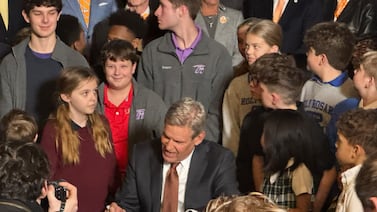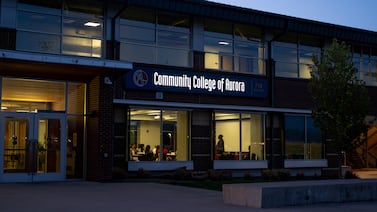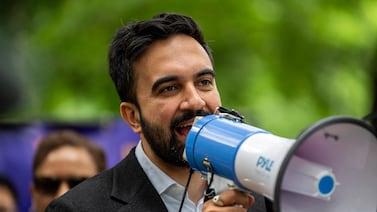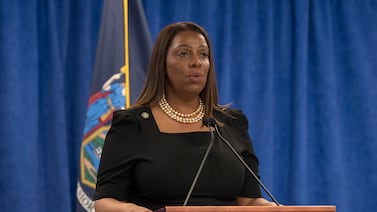The Jeffco school district is preparing to make recommendations this fall to close multiple elementary schools, kicking off its long-term plan to downsize its number of schools.
Jeffco district leaders say 49, or 58% of district elementary schools, currently have fewer than 250 students, and/or use less than 60% building capacity. Six elementary schools, in six different areas of the district, have fewer than 200 students, and also utilize less than 60% of their building’s capacity.
“While we have a large issue in this district, there are a few schools that are really facing dire situations with how small they are going into next school year and we must confront those,” said Lisa Relou, Jeffco’s chief of strategy and communications, who is overseeing the plan’s creation.
Jeffco, like many districts throughout the country and the metro area, has seen a steady decline in enrollment for years, which was aggravated by the pandemic. The district in 2021-22 served approximately 78,000 students, down from a peak of more than 86,700 in the fall of 2015. Districts say student populations have decreased due to lower birth rates, as well as higher costs of living in metropolitan areas pushing families out. Projections show the number of students in the next few years likely will continue to drop.
With fewer students, the district gets less money from the state, and then schools get less money from the district. While parents often value small classroom sizes, districts argue having multiple small schools is stretching resources too thin, and making for less adequate educational programming.
Jeffco leaders closed two elementary schools in the past two years, calling them emergency closures, citing problems maintaining programs, and giving little notice to parents. The district’s new plan, Regional Opportunities for Thriving Schools, was launched after the closure of Fitzmorris this year as a way to try to prevent emergency closures in the spring and provide parents more notice.
The district hasn’t said how many schools will be recommended for closure in the first round of the plan. But, the district is drafting a report that will detail factors the school board wants to consider in deciding whether to close a school.
That report, to be completed by June 30 on the status of all elementary schools, will include the school’s enrollment and staffing numbers, programming, and the building’s condition, among other details.
By August 31, the superintendent will make recommendations on which elementary school to close at the end of the 2022-23 school year. The board will vote on those recommendations before the end of November.
This fall’s recommendations will be based largely on enrollment and building utilization, but other factors might play a bigger role in future decisions such as whether the school hosts a unique program or what transportation options exist if students must go elsewhere.
“The approach is still evolving,” Relou said. “They’re all things we need to look at. They are all important components, but I think some things will stick out more than other things.”
In addition to district recommendations, district leaders are also planning to support principals who are working on plans of their own to merge schools. Those voluntary school mergers could be considered at the same time.
Relou said the district wants to limit how many schools are closed in one year so that district staff can support displaced families and students.
The other issue that hasn’t been decided is whether the district at some point will create a “bright line” – a number that would trigger closure. Some school board members said that having more clear benchmarks for what is considered “too few” students, might help parents.
But having such strict rules also might remove some of a district’s ability to consider other factors.
In Jeffco, for instance, Relou has said that some school buildings were made for small student populations, meaning that while they may have few students, they may be at or above building capacity. Regardless, Jeffco school board members and leaders want the focus to be on whether schools can provide good programs.
In the case of the last two emergency closures in Jeffco, district leaders said that the schools had to combine grade levels causing teachers to deal with different standards, and sometimes different curriculum resources, for students in one class. And in those cases, teachers didn’t have co-workers to plan and collaborate with for their grade levels. Before closing, Fitzmorris school leaders also described having a hard time offering after-school programming because even private providers were reluctant to offer services for so few students.
Now Jeffco is trying to define what it takes for a school to be what the district calls “thriving.”
One measure being discussed is ensuring a school is big enough to have two to three classes per grade level, so teachers can collaborate with co-workers. District leaders also have discussed that each school needs to have full-time art, music, and physical education teachers, so that students can have those classes consistently, rather than once every few weeks as is the case in some schools with shared teachers.
Board members also told district staff they want the district to track students who have been displaced by closures, in hopes of preventing the same students from being impacted more than once.
After November, the plan’s focus will become more broad, looking at middle and high schools as well. That means looking at how elementary schools feed into secondary schools, but also considering closing schools in higher grade levels.
Jeffco leaders say that this is one of many steps needed to eventually manage the district’s budget problems.
Enrollment has decreased faster than staffing levels, Relou said. And, as the district negotiates to increase staff salaries, likely using reserves for now, the district is going to have to cut expenditures to afford higher salaries in coming years.
As the district is working on the plan for school closures, Jeffco also has hired a consultant to evaluate how it spends its dollars. The district, like most others, allocates dollars to schools based on enrollment, called student-based budgeting, which began in Jeffco in the 2015-16 school year.
The method of funding gives principals flexibility to decide how to use their budgets. But as schools have had less enrollment, the district has had to step in to help schools pay for essentials. To help do that, Jeffco created a system where, if a school has more than a set level of enrollment, those schools must give back some of their per-student funding, to subsidize schools with too few students. Superintendent Tracy Dorland said the process is causing frustration for principals, as leaders must navigate confusing funding rules.
The consultant hired by the district will analyze the district’s spending, help district staff create a new formula for student-based budgeting, and help train principals so they are better prepared for creating their school budgets.
The district also will hire a consultant to run community engagement before the November vote on closures. The district plans to form committees in each affected articulation area, but stressed that the engagement would not be focused on whether a school should or should not close, but rather on how boundaries would shift, and how to support students in a transition.
Yesenia Robles is a reporter for Chalkbeat Colorado covering K-12 school districts and multilingual education. Contact Yesenia at yrobles@chalkbeat.org.






